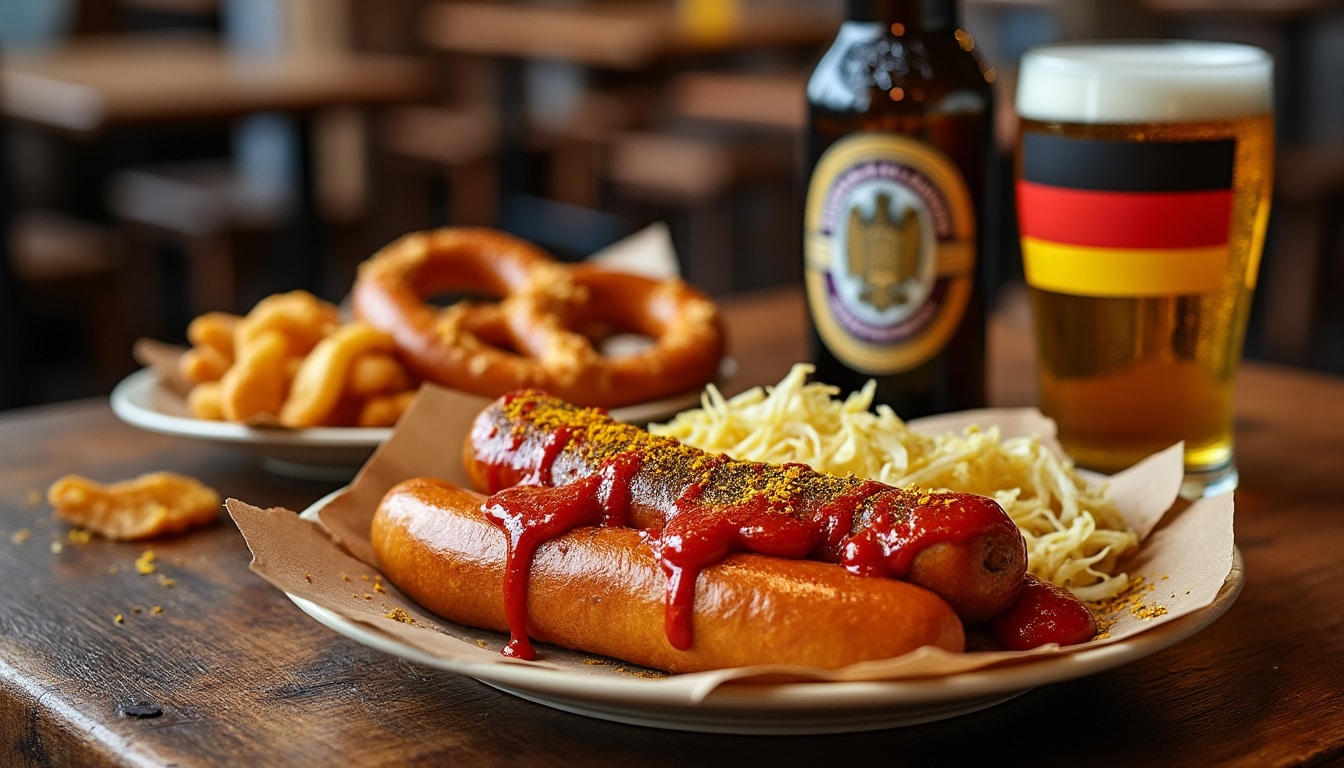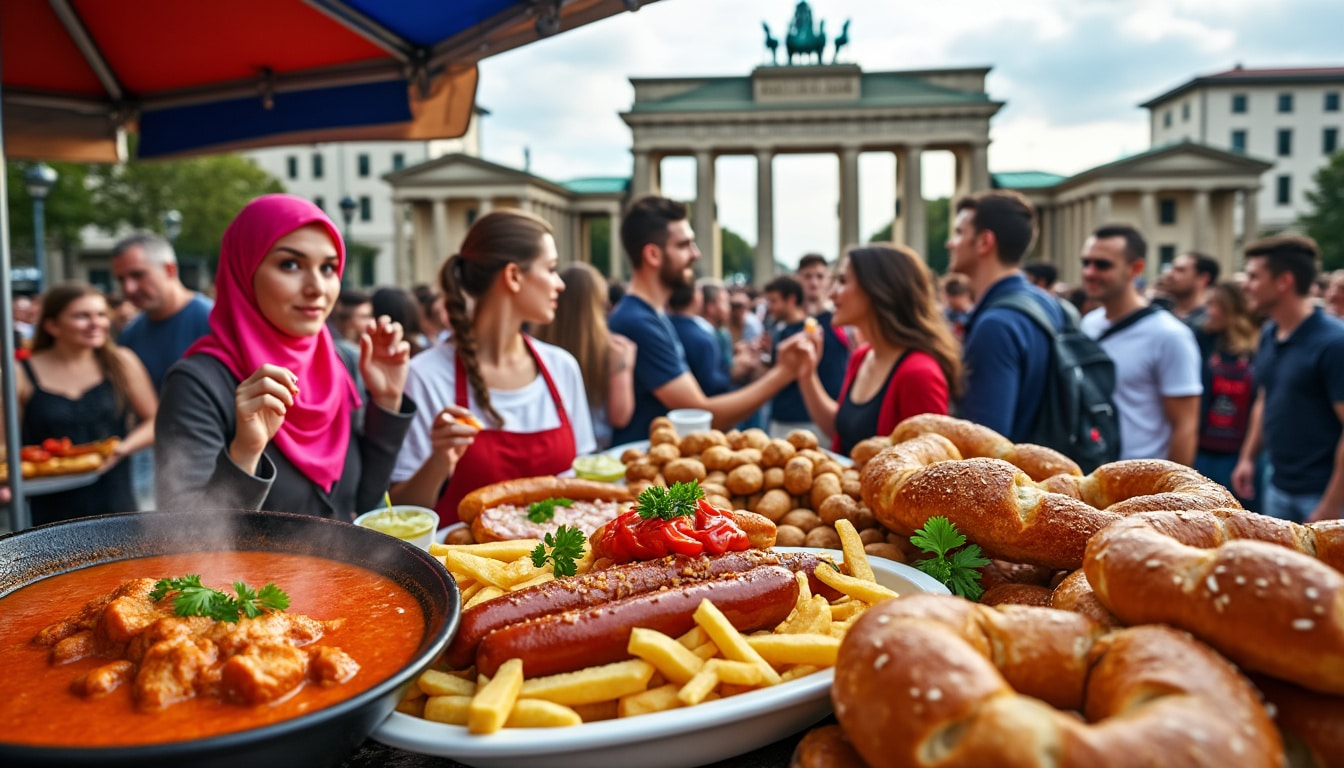The culinary landscape of Berlin is as dynamic and diverse as the city itself. As you walk through its vibrant streets, the scent of curry spices, sizzling meats, and freshly baked bread wafts through the air, inviting both locals and visitors to explore the myriad of flavors the city has to offer. Known for its eclectic mix of traditional and modern, German and international, Berlin’s food scene is a delicious reflection of its history and cultural diversity.
The Rich Traditions of German Cuisine in Berlin
When one thinks of German cuisine, images of hearty, meat-filled dishes often come to mind. However, Berlin’s culinary scene goes beyond just meat, offering a rich tapestry of flavors and ingredients that have evolved over centuries. Berlin’s position at the crossroads of Europe has allowed its cuisine to be influenced by neighboring countries such as Poland, Austria, and France, resulting in a diverse array of dishes that cater to a variety of palates.
A staple of Berlin’s traditional fare is the iconic Currywurst. Invented in Berlin in 1949, this dish embodies the city’s inventive spirit. It’s a delightful blend of sausage, curried ketchup, and crispy fries. It’s not just a meal; it’s a cultural symbol capturing Berlin’s innovative food culture. You can find Currywurst at iconic stalls like Curry 36, where locals and tourists alike queue for a taste.
Another beloved traditional dish is Eisbein mit Sauerkraut, or pork knuckle with sauerkraut. This dish is renowned for its crispy skin and rich, juicy meat, often complemented by the tangy punch of sauerkraut. It’s a celebration of flavors that exemplifies the comforting nature of German cuisine. Nowadays, this dish is priced around €16.00 per person, making it a hearty meal that doesn’t break the bank.
Berlin’s food culture is not limited to savory dishes. The Apple Strudel, a traditional German pastry, is a must-try for those with a sweet tooth. Filled with sweet, cinnamon-flavored apples, this flaky pastry makes for an excellent breakfast or dessert. The cost? Approximately €5.00 per person, making it an affordable indulgence.
As the cold Berlin wind sweeps through the city, Pretzels become a comforting staple. Their chewy texture and distinctive knot shape make them perfect companions to any meal, whether enjoyed solo or as a delicious sandwich base. You can grab a pretzel for around €2.00 each, and they pair exceptionally well with the endless varieties of Bier that Berlin offers.

Exploring Berlin Through Its Traditional Food
Berlin’s cuisine tells a story of history and innovation. The city’s approach to food can be explored through its numerous street food markets. These markets, bustling with energy and scents, offer an array of traditional options like Königsberger Klopse, traditional Prussian meatballs, and more modern adaptations of German fare.
Another noteworthy dish is the Berliner Pfannkuchen, a local version of a doughnut. It’s a sweet treat that’s traditionally enjoyed during the Fasching or Karneval season, though available year-round. These sugary delights typically cost around €5.00 per person and are a treat not to be missed.
The International Influence on Berlin’s Food Scene
Berlin is not just about traditional German dishes. The city’s cosmopolitan nature is reflected in its food, where international cuisines have found a home and a heart. One cannot talk about Berlin’s international cuisine without mentioning the Döner Kebab. Introduced by Turkish immigrants, these delicious wraps filled with succulent rotisserie meats and fresh vegetables have become as synonymous with Berlin as Currywurst. Every corner of the city offers its unique take on this dish, and places like Kebab House Berlin are always bustling with patrons eager for a taste.
Beyond the Döner Kebab, Berlin’s food scene boasts a rich variety of international flavors. The Vietnamese community has contributed greatly to the city, with Pho and Banh Mi becoming local favorites. Such diversity is evident in Berlin’s vibrant neighborhoods like Kreuzberg and Prenzlauer Berg, where Asian eateries sit comfortably alongside traditional German taverns.
For those seeking a more contemporary flavor, Berlin houses a growing Japanese culinary presence, bringing sushi, ramen, and izakayas to the forefront. These venues often focus on seasonal ingredients, and many employ traditional techniques with a modern twist. As a testament to their popularity, a meal at one of these establishments ranges between €15.00 and €30.00, a worthwhile investment for a rich cultural experience.
Lastly, Italian cuisine finds ample representation in Berlin. From rustic trattorias to modern Italian bistros, dishes like Pasta alla Carbonara and Margherita Pizza find new interpretations with each chef’s unique style.
International Food Markets in Berlin
The city’s love for international flavors extends to its market scene. From the Turkish Market in Kreuzberg, offering spices and delicacies, to the Markthalle Neun’s Street Food Thursday, where chefs from around the world present culinary creations, these markets are a testament to Berlin’s diverse palate.
- 🌍 Turkish Market, Kreuzberg: For spices and traditional Turkish foods.
- 🌐 Markthalle Neun: A hub for global street food every Thursday.
- 🍣 Ramen at Kuchi: Enjoy authentic Japanese cuisine in Berlin.
These experiences highlight Berlin’s openness to global cultures, making it a true melting pot of flavors that blends the traditional with the contemporary.
The Rise of Vegan and Vegetarian Delights in Berlin
As a city known for its progressive attitude, Berlin has embraced the vegan and vegetarian food revolution with enthusiasm. More than ever before, restaurants offering plant-based options are thriving, driven by both local demand and a global shift towards healthier, more sustainable eating habits.
Restaurants emphasizing vegan and vegetarian menus have sprung up across the city, offering everything from vegan versions of beloved German classics to innovative plant-based dishes that satisfy and surprise. Such establishments highlight how Berlin is at the forefront of the culinary future.
Vegan Currywurst is a hit among both vegans and meat-eaters looking for healthier options. Alongside it, dishes like vegan Schnitzel offer the same crunchy satisfaction as their meat-based counterparts. The proliferation of these dishes in eateries like Vego Foodworld speaks to Berlin’s role as a leading city for vegan cuisine innovation.
For dessert, vegan cafes offer treats like Vegan Berliner Pfannkuchen and plant-based ice creams. These establishments, such as Brammibal’s Donuts, cater to the city’s growing vegan community.
Pioneering Vegan Restaurants in Berlin
Many of Berlin’s vegan restaurants emphasize sustainable practices and locally-sourced ingredients. A few noteworthy mentions include:
- 🌿 Kopps: Known for its innovative vegan dishes and elegant dining experience.
- 🍃 Lucky Leek: Offers a creative and gourmet plant-based menu.
- 🥦 Plant Base: A café that combines vegan eats with community events.
Berlin’s vegan movement is not just about food; it’s about embracing a lifestyle that supports sustainability and ethical food choices, making the city’s culinary scene more inclusive and diverse.
Cafés and Coffee Culture in Berlin
The coffee house tradition in Berlin is one that pairs well with its vibrant cultural backdrop. Berlin’s coffee scene is as eclectic as its eateries, offering everything from classic brews to modern, artisanal coffees. Cafés serve as social hubs where locals and tourists alike gather to work, relax, or simply observe the city’s vibrant life.
The Café Experience in Berlin
Cafés like Café Einstein Stammhaus offer a classic coffeehouse atmosphere, where the art of brewing coffee blends with historical ambiance. Meanwhile, modern cafés such as The Barn focus on specialty coffee, sourcing beans from notable single-origin farms around the world.
A typical cafe menu may include:
| ☕ Coffee Type | 🍰 Dessert Pairing |
|---|---|
| Espresso | Pretzel |
| Cappuccino | Berliner Pfannkuchen |
| Latte Macchiato | Vegan Apple Strudel |
Berlin’s coffee culture is a microcosm of its larger culinary diversity, with an emphasis on artisanal craftsmanship and a nod to both tradition and innovation. This cafe culture is emblematic of how Berlin blends the old with the new, drawing people into its distinctive charm.
Street Food Markets and Beyond: Indulging in Berlin’s Eats
No visit to Berlin would be complete without a taste of its famous street food markets. These bustling hubs of activity offer a kaleidoscope of culinary experiences, encapsulating the city’s spirit of diversity and innovation. Whether you’re a fan of traditional German fare or eager to explore global tastes, street food markets are a haven for food lovers.
The Best Street Food Markets in Berlin
Berlin’s street food markets are celebrated for their vibrant atmosphere and diverse offerings.
- 🍽️ Bite Club: A floating street food market featuring diverse stalls along the Spree River.
- 🌐 Street Food auf Achse: Offers international delicacies from tacos to Thai curry.
- 🍔 Prinzessinnengärten: Combines street food with urban gardening projects.
Each of these markets captures the essence of Berlin’s culinary landscape, showcasing the city’s rich tradition of street food and its openness to international influences. Whether you’re indulging in a classic Currywurst or trying vegan wraps, these markets offer something for everyone.
Beyond the gastronomic delights, these markets are a testament to the dynamic community spirit that characterizes Berlin, making them a must-visit on any culinary itinerary.
FAQ about Eating in Berlin
- Q: What is a must-try street food in Berlin?
- Q: Are there vegan options in Berlin?
- Q: How are the coffee houses in Berlin?
- Q: Where can I find international cuisine in Berlin?
- Q: What is the best time to explore Berlin’s street food markets?

